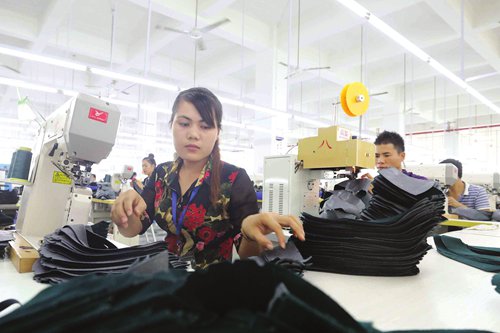
From the People's Daily App.
This is Story in the Story.
Illegal border-crossing from Vietnam to China, a problem which was frequently unveiled since 2000 but has been largely resolved through joint efforts from both countries, has once again sparked discussion in China.
Vietnamese people smugglers tried to sneak into South China's Guangxi Zhuang Autonomous Region and then to Guangdong Province where low-skilled workers were needed at the time.
Dongxing and Pingxiang, two cities located on the border between China and Vietnam, are seen as the main channels for Vietnamese illegal workers to enter China to seek their "Chinese dream."
During that time, almost every day along the China-Vietnam border line in Guangxi, Vietnamese entered China through unguarded paths. They then poured into factories in Guangdong and Fujian provinces by coach and train, filling in the gap of the labor shortage in China's coastal regions.
The number of Vietnamese stowaways to China has slumped as the Chinese government tightened border regulations and cracked down on the human trafficking networks, officials from the Dongxing government said.
Today’s Story in the Story looks at how things have changed with some Chinese border cities now actively attracting more Vietnamese workers.

Some Vietnamese workers gather at Honghe, Southwest China's Yunnan Province in March 2018. (Photos: VCG)
More than a decade ago, in the Chinese border city Pingxiang, many small groups of Vietnamese often made their way back and forth through unguarded mountain trails near the entry port. Thousands of people reportedly traveled across the border every day.
The influx of illegal workers from Vietnam brought multiple challenges to China's social security and border management, according to Xinhua.
China's labor shortage was the driving reason why Vietnamese workers entered the country. The number of illegal Vietnam workers reaches its peak from December to April every year during the sugarcane harvest season in Guangxi. There is a similar labor shortage prevailing in coastal cities where hard-working, low-wage workers are needed.
In June 2013, Le Thi Dung and 16 of her fellow villagers entered Dongxing, Guangxi, across the Beilun River, the border river between China and Vietnam. Le Thi Dung comes from a poor village in Central Vietnam's Ha Tinh Province. It is her dream to earn a living in China. But their "Chinese gold rush dream" was shattered when they were seized by border police on the second day after they illegally entered China.
"Some Chinese factories pay 'snakeheads' to find cheap Vietnamese labor. 'Snakeheads' use their Vietnamese contacts to find workers, lure them with high salaries, and then smuggle them across the border to work in factories in southern China," an official at the Fangchenggang Frontier Defense Police station was quoted as saying.
"The smugglers are generally familiar with the border situation between China and Vietnam. They often take advantage of the all-around trails in the border area to bypass border checkpoints and sneak around at night, making it more difficult for border authorities to crack down," he said.

Vietnamese employees work in a factory of Guangxi Zhuang Autonomous Region. (Photos: VCG)
In response to the illegal entry of Vietnamese workers, China's border authorities have taken many recent measures, including strengthening inspection at border checkpoints and implementing a 24-hour duty system.
"The smuggling of Vietnamese into China was indeed rampant before 2015. But 2015 was a watershed year, as China and Vietnam cooperated to allow Vietnamese border residents to enter China's border areas to work legally with valid documents," said Gu Xiaosong, an expert on Southeast Asian studies at the Guangxi Academy of Social Sciences.
Vietnamese border residents can enter China with their border permit, and the whole process takes as little as 10 minutes, said Zhu Guangbao, the head of human resources and social security administration in Dongxing.
Zhu said there are around 10,000 Vietnamese workers in Dongxing, among whom 2,000 to 3,000 have a legal working permit. Most of them travel back and forth on the same day, earning money in temporary jobs.
Nguyen Thi Ngoc, from Mong Cai in Vietnam, came to China and became a worker in a local printing house five years ago. She was soon promoted to be a manager due to her diligence.
"Vietnamese people liked to go out to work in Japan and Singapore before, but now they are more yearning for China. I choose to work in China because of a more stable income and complete welfare," she said.
Now, Chinese border and public security authorities meet with their Vietnamese counterparts every year to discuss measures to combat illegal entry, stay and employment.
(Produced by Nancy Yan Xu, Brian Lowe, Lance Crayon and Paris Yelu Xu. Music by: bensound.com. Text from Global Times.)


